Pins may be small components, but they play a critical role in various industrial and mechanical applications.
These fastening elements provide secure connections, precise alignment, and structural stability, ensuring the smooth operation of machinery, mga kagamitan, and assemblies.
This comprehensive guide explores the different types of industrial pins, their manufacturing processes, mga materyales, Mga kalamangan, at mga aplikasyon.
Dagdag pa, it outlines key factors to consider when selecting the right pin fastener for specific industrial needs.
1. Mga Batayang Konsepto at Terminolohiya
A thorough understanding of basic concepts and terminology is fundamental when working with pin fasteners,
as it lays the groundwork for designing and selecting the appropriate type of pin for any application.
Ano ang mga Pin?
Pins are a category of fasteners typically used to secure, align, or join two or more components together.
Unlike threaded fasteners, pins generally lack internal threads and function by being inserted into pre-drilled or punched holes.
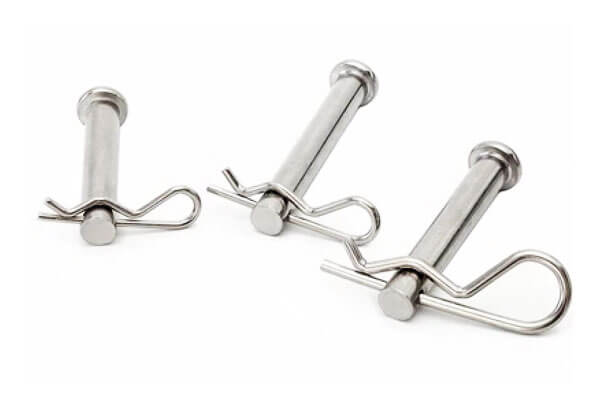
Once in place, they provide a permanent or semi-permanent connection by acting as a pivot or alignment element within an assembly.
This simple yet effective mechanism is critical for ensuring the stability and functionality of mechanical systems.
Key Terminolohiya sa Pin Fastening
A clear grasp of specialized terminology is essential for effective communication and design in the field of pin fasteners. Here are some of the most important terms associated with pins:
- Shank:
The shank is the main body of the pin, typically cylindrical or tapered. It is designed to fit snugly within a hole, ensuring proper alignment and load distribution. - Ulo:
The head is the portion of the pin that remains visible after installation.
It often provides a bearing surface and may be designed in various shapes (hal., round, countersunk) to suit both functional and aesthetic requirements. - Mandrel:
Found primarily in blind rivet variants, the mandrel is an internal rod that assists in the expansion of the pin during installation.
Once the pin is secured, ang mandrel break off, Pag-iwan ng malinis na, secure joint. - Magmaneho ng Pin:
In certain types of pins such as drive rivets, a drive pin is used to force the body of the pin to expand, thereby locking the fastener in place.
This feature facilitates rapid and efficient installation. - Nakakainis:
This process involves deforming the end of a pin, typically by hammering or pressing, to create a second head that locks the pin within the assembly.
Upsetting is critical to ensure that the pin remains firmly in place under operational loads. - Set/Setting:
The term “set” refers to the state when the pin has been fully installed and secured, with its tail or mandrel deformed to create a second head.
A properly set pin ensures maximum holding strength and durability.
Ang Mga Pangunahing Mekanika ng Pin Fastening
Pins function by being inserted into a pre-aligned hole and then being secured by a mechanical deformation process. This process can vary depending on the type of pin.
Halimbawang, with solid pins, the tail is typically deformed using a hammer or specialized tool, which creates a second head that holds the assembly together.
Sa kabilang banda, blind or self-piercing pins use internal mechanisms, such as a mandrel or drive pin, to expand the fastener and lock it securely in place.
- Pagkakahanay:
Proper alignment of the components is essential for ensuring that the pin fits accurately into the pre-drilled hole, which maximizes load transfer and minimizes potential movement. - Interference Fit:
Many pins are designed to create an interference fit, meaning that the pin’s diameter slightly exceeds that of the hole, ensuring a tight, secure connection once installed. - Pamamahagi ng Load:
Once installed, the pin distributes the load evenly across the joint, providing both structural integrity and resistance to dynamic stresses such as vibrations and impacts.
2. Mga Uri ng Industrial Pins
Sa bahaging ito, we provide an in-depth look at the different types of industrial pins, discussing their unique design features, mga paraan ng pag install, at tipikal na mga aplikasyon.
Mga Pin ng Cotter (Hatiin ang mga Pin)
Cotter pins, also known as split pins, are U-shaped fasteners featuring two prongs that are bent over after insertion to secure the connection.
Their simple design and ease of installation make them ideal for preventing nuts and bolts from loosening.
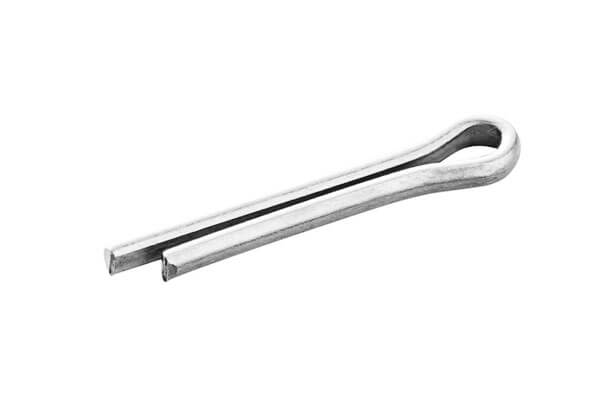
Cotter pins excel in applications that require a reliable, permanent lock, such as in automotive linkages and heavy machinery.
Mga Pin ng Dowel
Dowel pins are precision-engineered cylindrical rods that serve primarily as alignment elements.
They ensure accurate positioning of components by fitting snugly into corresponding holes.
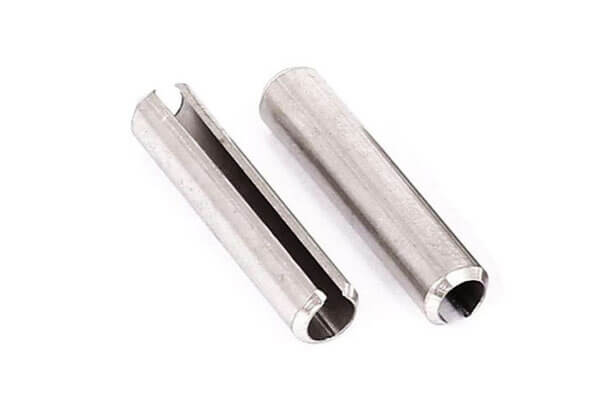
In high-precision manufacturing—such as in aerospace assemblies or medical devices—dowel pins maintain strict tolerances and provide the necessary stability for critical joints.
Spring Pins (Mga Roll Pin)
Spring pins, commonly known as roll pins, are hollow, cylindrical fasteners with a longitudinal slit that allows them to compress during installation and then expand to secure the joint.
Their unique design offers excellent vibration resistance and is especially useful in applications where maintaining consistent alignment is crucial.
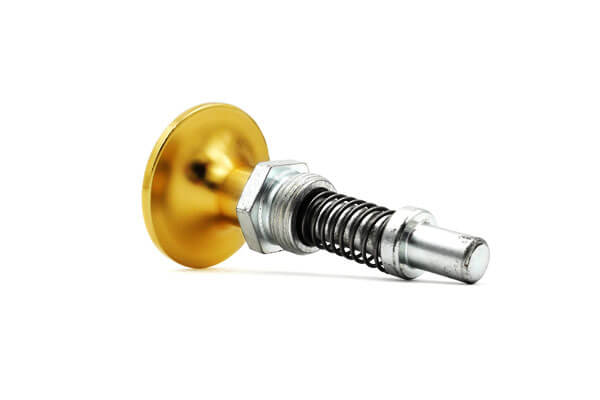
Spring pins are frequently employed in automotive and industrial systems, where reliability under dynamic loading is essential.
Mga Pin ng Taper
Taper pins feature a gradual reduction in diameter from one end to the other, ensuring a tight, interference fit when inserted into a tapered hole.
This design provides precise positioning and strong resistance against rotational forces,
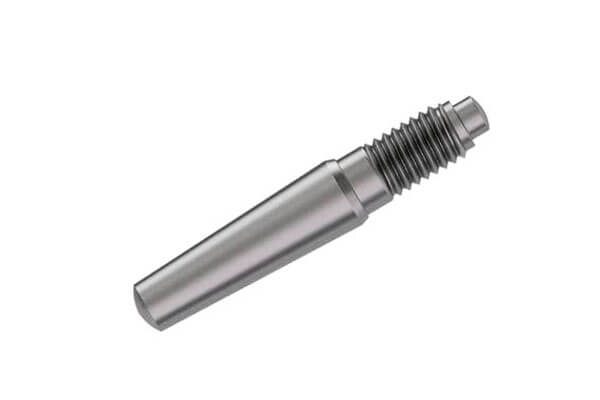
making taper pins well-suited for mechanical assemblies in automotive transmissions and heavy machinery.
Mga Pin ng Hitch
Hitch pins are straight fasteners with integrated locking mechanisms, specifically designed to secure couplings in applications such as trailer hitches and agricultural equipment.
Their robust design and ease of manual insertion make them a popular choice for ensuring safety and reliability in high-stress environments.

Grooved Pins
Grooved pins include one or more longitudinal grooves along their length, which enhance their retention capability by increasing friction between the pin and the assembly.
These pins are especially beneficial in applications where preventing slippage is critical, such as in precision equipment and industrial machinery.
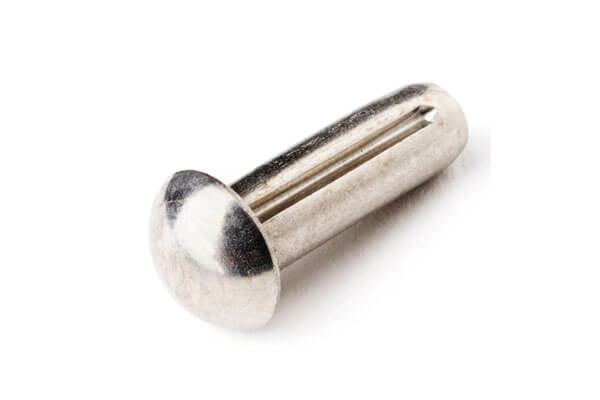
Mga Linchpin
Mga Linchpin, often used in mechanical assemblies involving rotational components, serve as self-locking devices that prevent wheels or other parts from detaching from axles.
Their secure locking mechanism ensures safety in heavy-duty transportation and machinery applications, making them a staple in sectors like agriculture and construction.
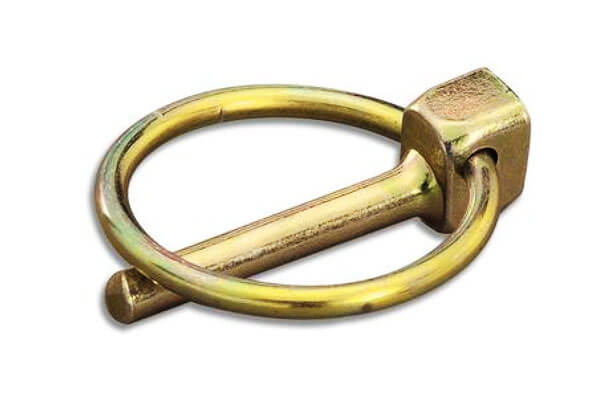
Mga Knurled Pin
Knurled pins incorporate a textured surface with ridges or knurls that improve grip during installation and removal.
This enhanced surface friction makes them ideal for applications where temporary alignment or adjustable fastening is required, such as in tool assembly and experimental prototypes.
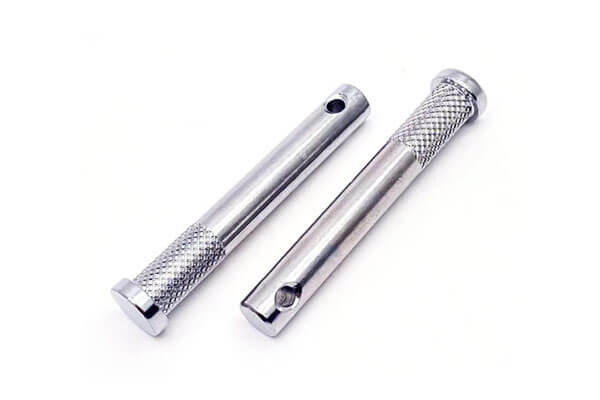
Shear Pins
Shear pins are designed to intentionally fail under specific loads, serving as a protective mechanism that safeguards machinery from excessive force.
By breaking at a predetermined stress level, shear pins prevent more critical components from being damaged.
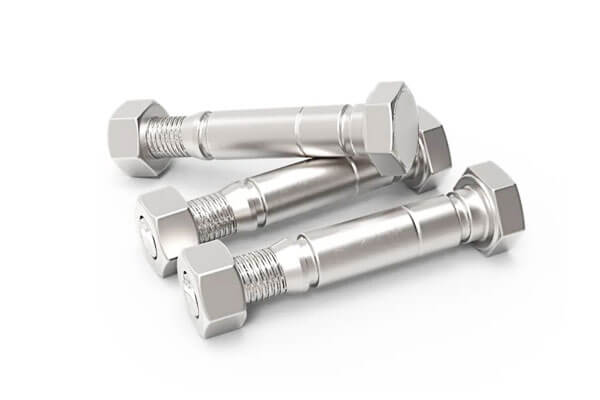
This characteristic makes them essential in safety-critical applications in industries such as automotive and aerospace.
Mga pin ng wire lock
Wire lock pins feature an integrated wire loop that locks the pin in place, ensuring a secure connection even under dynamic loads.
Their ease of installation and robust locking mechanism make them suitable for applications where quick assembly and disassembly are advantageous, such as in modular furniture and consumer electronics.
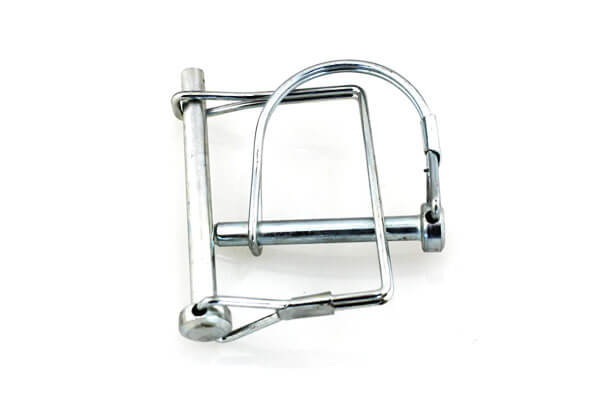
Mga pin na may L handle
L-handle pins incorporate an L-shaped handle that simplifies the installation and removal process.
Ang disenyo na ito ay partikular na kapaki pakinabang sa mga application kung saan kinakailangan ang madalas na pag aalis ng pagtitipon, tulad ng sa adjustable makinarya o maintenance-intensive system.
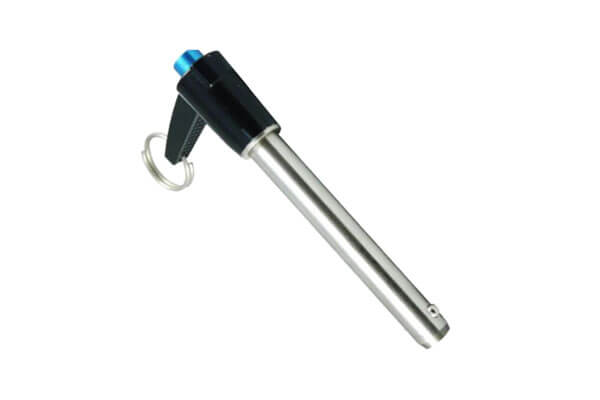
R-Clips (R-Pins)
Mga R-clip, kilala rin bilang R-pins, ay nailalarawan sa pamamagitan ng kanilang natatanging "R" hugis.
Ang mga fasteners ay karaniwang ginagamit sa pag secure ng mga axles at shafts, kung saan ang kanilang natatanging disenyo ay nagsisiguro ng isang matibay na hold, nag aambag sa pangkalahatang katatagan ng pagtitipon.
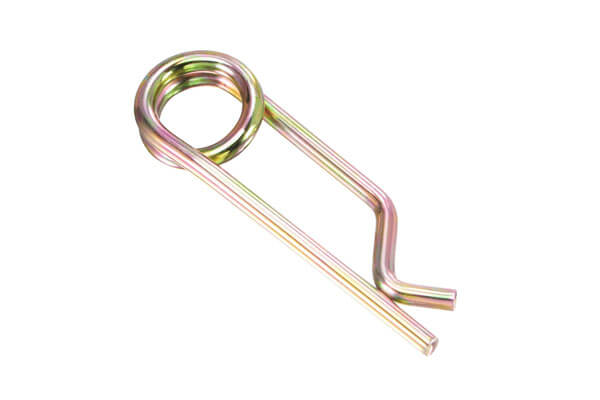
Mga Pin ng Clevis
Ang mga clevis pin ay mga cylindrical fastener na ginagamit kasabay ng isang cotter pin o split pin upang lumikha ng isang pivot point.
Ang mga ito ay malawakang ginagamit sa agrikultura kagamitan at makinarya, kung saan sila mapadali ang makinis na paggalaw at maaasahang load transfer sa loob ng mga mekanikal na linkages.
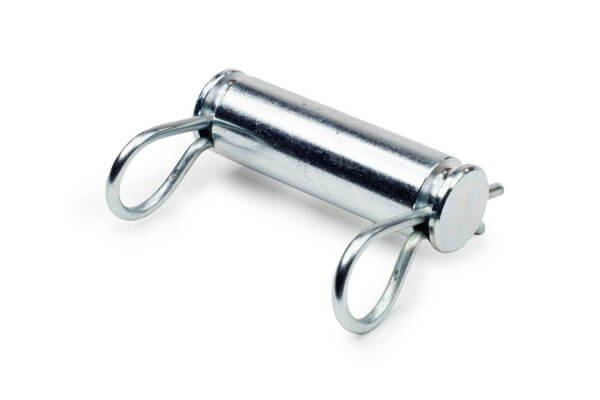
Mga Detent Pin
Nagtatampok ang mga detent pin ng isang mekanismo ng bola na may karga ng tagsibol na nag lock ng pin sa lugar sa sandaling nakapasok.
This design provides a secure and reusable fastening solution, particularly useful in applications that require frequent engagement and disengagement without compromising on reliability.
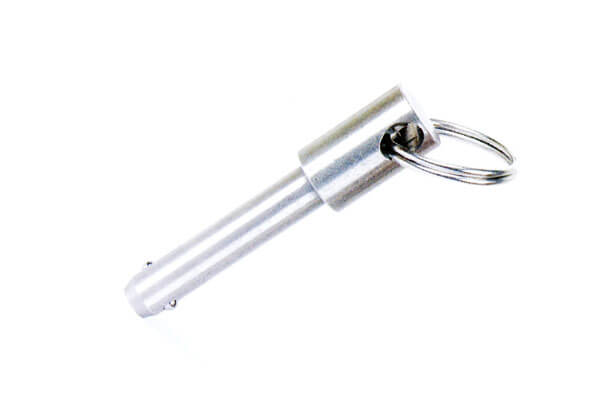
Mga Paulit ulit na Spring Latch Pins
Retractable spring latch pins are designed with a retractable mechanism that allows for quick locking and unlocking.
These pins are especially valuable in high-frequency applications where rapid assembly and disassembly are critical, such as in modular systems and consumer products.
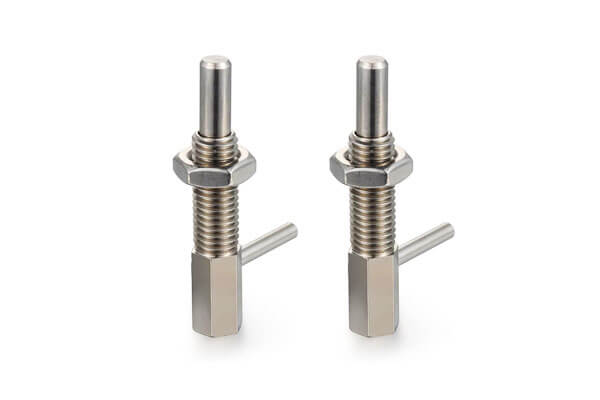
3. Mga Proseso ng Paggawa para sa mga Pin Fasteners
The production of pin fasteners involves a blend of traditional methods and modern technology, ensuring high precision, tibay ng katawan, and consistent quality.
Manufacturers employ various techniques—ranging from CNC machining to forging and stamping—to produce pins that meet the rigorous demands of modern industrial applications.
This section provides an in-depth look at the key manufacturing processes used to create high-quality pin fasteners.
CNC Machining
CNC machining is widely used for producing pins that require intricate details and tight tolerances.
Sa prosesong ito, a computer numerical control machine precisely removes material from a solid block of metal to achieve the desired pin geometry.
- Katumpakan at Pagkakapare pareho:
CNC machining delivers exceptional accuracy, making it ideal for manufacturing small, detailed pins used in precision instruments and electronic devices. - Kakayahang umangkop ng Materyal:
This process accommodates a variety of materials, kasama na ang bakal, aluminyo, at tanso, ensuring that the final product meets specific performance requirements. - Kahusayan:
By automating the machining process, manufacturers can achieve high throughput with minimal human intervention, which reduces production time and labor costs.
Stamping
Stamping is an efficient method for mass-producing pins from metal sheets. This process uses high-speed presses and precision dies to cut and form the desired shape from a flat sheet.
- Mataas na Dami ng Produksyon:
Stamping is ideal for large-scale production, allowing manufacturers to produce consistent and uniform pins in high quantities. - Pagiging Epektibo sa Gastos:
The method minimizes material waste by cutting the desired shape from the sheet with high accuracy, lowering overall production costs. - Bilis:
The rapid nature of stamping makes it particularly attractive for applications requiring fast turnaround times.
Pagbubuo ng mga
Forging is employed to create pins that demand superior strength and durability.
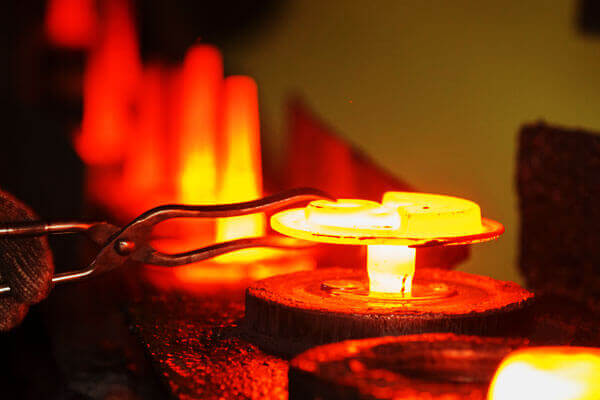
Sa prosesong ito, a heated metal bar is shaped under high pressure, resulting in a refined grain structure that enhances mechanical properties.
- Enhanced Strength:
Forged pins exhibit improved toughness and resistance to fatigue, making them well-suited for heavy-duty applications such as automotive and aerospace assemblies. - Uniform Microstructure:
The high-pressure deformation results in a consistent microstructure that minimizes internal defects, thereby increasing the reliability of the fastener. - Versatility:
Forging allows for the production of both standard and custom pin designs, catering to applications where high load-bearing capacity is essential.
Paggamot ng Heat
Heat treatment plays a pivotal role in optimizing the mechanical properties of pin fasteners.
This process involves controlled heating and cooling to alter the microstructure of the metal, thereby enhancing hardness, lakas ng loob, at magsuot ng resistensya.
- Pagsasama ng Proseso:
After forming the basic shape through machining, pag stamp ng, o pagkukubli, pins often undergo heat treatment processes
such as annealing, pagpapawi ng, at tempering upang makamit ang ninanais na mga katangian. - Pagpapahusay ng Pagganap:
Sa pamamagitan ng heat treatment, tagagawa ay maaaring iakma ang katigasan at ductility ng pin, pagtiyak na ito ay makatiis sa mataas na mga stress sa pagpapatakbo at nagpapalawak ng buhay ng serbisyo nito. - Pagtiyak ng Kalidad:
Advanced na mga pamamaraan ng paggamot ng init, tulad ng induction heating at laser heat treatment,
magbigay ng tumpak na temperatura control at pare pareho ang paggamot, higit pang pagpapahusay ng pagganap ng materyal.
Kontrol ng Kalidad at Inspeksyon
Ang mahigpit na kontrol sa kalidad ay kritikal sa produksyon ng pin fasteners. Ang mga tagagawa ay nagpapatupad ng mga advanced na pamamaraan ng inspeksyon upang matiyak na ang bawat pin ay nakakatugon sa mga mahigpit na pamantayan sa pagganap.
- Pagsubok na Hindi Nakasisira (NDT):
Mga pamamaraan tulad ng X-ray imaging, pagsusuri sa ultrasonic, at optical microscopy ay ginagamit upang matukoy ang mga panloob na depekto at patunayan ang integridad ng materyal nang hindi nasisira ang pin. - Pag-verify ng Dimensyon:
Mga tool sa pagsukat ng katumpakan, kabilang ang mga laser scanner at coordinate pagsukat machine (CMM), confirm that each pin adheres to tight dimensional tolerances. - Process Monitoring:
Real-time monitoring systems, often integrated with digital control technologies, help maintain consistent quality throughout the manufacturing process.
4. Mga Karaniwang Materyales para sa mga Pin Fasteners
Selecting the right material for pin fasteners is crucial for ensuring durability, pagiging maaasahan, and optimal performance in various applications.
The choice of material directly impacts the pin’s strength, paglaban sa kaagnasan, bigat ng katawan, and overall functionality.
Different industries require different materials based on environmental conditions, load-bearing capacity, and mechanical properties.
This section provides an in-depth look at the most commonly used materials for manufacturing pin fasteners, along with their characteristics and applications.
Carbon Steel
Pangkalahatang ideya: Carbon bakal is one of the most commonly used materials for pin fasteners due to its high strength, tibay ng katawan, at abot kayang presyo.
It consists primarily of iron and carbon, with varying amounts of manganese and other elements to enhance specific properties.
Mga Pangunahing Katangian:
- Mataas na Lakas: Capable of withstanding heavy loads and mechanical stress.
- Epektibo sa Gastos: More affordable compared to stainless steel and titanium.
- Maraming nalalaman: Suitable for a wide range of industrial applications.
Mga Karaniwang Aplikasyon:
- Mga bahagi ng sasakyan (mga ehe, mga shaft, at mga sistema ng suspensyon).
- Structural assemblies in construction.
- Heavy machinery and equipment.
Mga Dapat Isaalang alang:
Carbon steel is prone to rust and corrosion, so additional surface treatments
such as galvanization, black oxide coating, or zinc plating are often applied to enhance corrosion resistance.
Hindi kinakalawang na asero
Pangkalahatang ideya: Hindi kinakalawang na asero is highly valued for its excellent corrosion resistance, lakas ng loob, at tibay.
It contains chromium, which forms a passive oxide layer that protects the metal from rust and oxidation.
Mga Pangunahing Katangian:
- Superior kaagnasan paglaban: Ideal for humid, marine, and chemically aggressive environments.
- Mataas na Lakas at Tibay: Withstands mechanical stress and wear over time.
- Aesthetic Appeal: Often used in applications requiring a clean, makintab na hitsura.
Mga Karaniwang Aplikasyon:
- Marine and offshore equipment.
- Medical devices and surgical instruments.
- Food processing and pharmaceutical machinery.
- Aerospace and defense components.
Mga Dapat Isaalang alang:
Stainless steel is generally more expensive than carbon steel but offers superior longevity and lower maintenance costs.
tanso
Pangkalahatang ideya: tanso is an alloy of copper and zinc, offering a unique combination of corrosion resistance, machinability, at aesthetic appeal.
It is widely used in applications requiring non-magnetic properties and a polished appearance.
Mga Pangunahing Katangian:
- Good Corrosion Resistance: Particularly effective against moisture and mild chemicals.
- Easy to Machine: Allows for precise and intricate pin designs.
- Non-Sparking and Non-Magnetic: Ideal for electrical and hazardous environments.
Mga Karaniwang Aplikasyon:
- Electrical connectors and circuit board fasteners.
- Decorative hardware and architectural elements.
- Marine and plumbing applications.
Mga Dapat Isaalang alang:
Brass is softer than steel, making it less suitable for heavy-load applications. Gayunpaman, its corrosion resistance and workability make it a preferred choice for specialized applications.
Aluminyo
Pangkalahatang ideya: Aluminyo is a lightweight yet strong material commonly used in applications where weight reduction is essential. It naturally forms an oxide layer that provides corrosion resistance.
Mga Pangunahing Katangian:
- Magaan ang timbang: Ideal for aerospace and automotive applications where weight reduction is critical.
- Corrosion-Resistant: Suitable for outdoor and marine environments.
- Good Conductivity: Used in electrical and thermal applications.
Mga Karaniwang Aplikasyon:
- Aircraft and aerospace components.
- Lightweight machinery and sports equipment.
- Electrical and heat dissipation systems.
Mga Dapat Isaalang alang:
Although aluminum is highly resistant to corrosion, it is softer than steel and may not be suitable for high-stress applications.
Titanium
Pangkalahatang ideya: Titanium is an advanced engineering material known for its exceptional strength-to-weight ratio, paglaban sa kaagnasan, at biocompatibility.
It is often used in demanding environments where high performance is required.
Mga Pangunahing Katangian:
- Mataas na Ratio ng Lakas sa Timbang: Stronger than steel but significantly lighter.
- Napakahusay na Paglaban sa Kaagnasan: Withstands extreme temperatures and harsh environments.
- Biocompatible: Ideal for medical and aerospace applications.
Mga Karaniwang Aplikasyon:
- Aerospace and military components.
- Medical implants and surgical equipment.
- High-performance automotive and sports equipment.
Mga Dapat Isaalang alang:
Titanium is more expensive than other metals, and its machining process requires specialized tools, increasing production costs.
Tanso
Pangkalahatang ideya: Tanso is known for its excellent electrical and thermal conductivity, making it an essential material in electrical and electronic applications.
It also possesses natural antimicrobial properties.
Mga Pangunahing Katangian:
- Superior Conductivity: Ideal for electrical and thermal applications.
- Paglaban sa kaagnasan: Develops a protective patina over time.
- Mga Katangian ng Antimicrobial: Suitable for medical and food-grade applications.
Mga Karaniwang Aplikasyon:
- Electrical components and grounding pins.
- Plumbing and HVAC systems.
- Antimicrobial surfaces in healthcare environments.
Mga Dapat Isaalang alang:
Copper is relatively soft and may deform under high mechanical stress, making it unsuitable for heavy-duty fastening applications.
Mga haluang metal ng Nickel
Pangkalahatang ideya: Nickel-based alloys, such as Monel and Inconel, are engineered for extreme environments, offering outstanding strength, paglaban sa init, at paglaban sa kaagnasan.
Mga Pangunahing Katangian:
- Exceptional Heat and Corrosion Resistance: Performs well in high-temperature and chemically aggressive conditions.
- High Strength and Hardness: Provides excellent durability under extreme stress.
- Resistant to Oxidation and Wear: Maintains structural integrity in demanding environments.
Mga Karaniwang Aplikasyon:
- Aerospace and turbine engines.
- Chemical processing and power generation.
- Marine and offshore drilling components.
Mga Dapat Isaalang alang:
Nickel alloys are expensive and require specialized machining processes, increasing production costs.
plastik na plastik (Naylon, Polycarbonate, at PEEK Pins)
Pangkalahatang ideya: While metal pins dominate industrial applications, certain engineering mga plastik na are used when weight reduction, pagkakabukod ng kuryente, or chemical resistance is required.
Mga Pangunahing Katangian:
- Lightweight and Non-Conductive: Ideal for electrical and electronic applications.
- Kaagnasan at Paglaban sa Kemikal: Suitable for harsh chemical environments.
- Paglaban sa Epekto at Wear: Some high-performance plastics, such as PEEK, offer superior durability.
Mga Karaniwang Aplikasyon:
- Electrical insulation components.
- Food and pharmaceutical processing equipment.
- Lightweight fasteners in medical and aerospace applications.
Mga Dapat Isaalang alang:
Plastic pins have lower mechanical strength compared to metal fasteners, limiting their use in high-load applications.
5. Mga Pangunahing Kalamangan at Kahinaan ng mga Pin Fasteners
Pin fasteners are widely used across various industries due to their versatility, pagiging maaasahan, and ease of installation.
Gayunpaman, like any fastening solution, they have both strengths and limitations.
Understanding their key advantages and disadvantages helps engineers and manufacturers determine the most suitable fastening method for specific applications.
5.1. Mga Pangunahing Bentahe ng Pin Fasteners
Mataas na Lakas at Tibay
- Pin fasteners, particularly those made from steel, hindi kinakalawang na asero, o titan, offer exceptional mechanical strength.
- They can withstand high shear and tensile forces, making them ideal for applications in heavy machinery, aerospace, and automotive engineering.
Ligtas at Maaasahang Pagbigkis
- Many pin types, such as dowel pins and taper pins, provide precise alignment and tight fits, reducing movement between components.
- Certain pins, such as shear pins, are designed to fail under excessive loads, preventing damage to critical machinery components.
Kaagnasan at Paglaban sa Kapaligiran
- Hindi kinakalawang na asero, tanso, aluminyo, and titanium pins exhibit excellent resistance to rust and corrosion, making them ideal for marine, medikal na, at panlabas na mga application.
- Surface treatments like galvanization, pag anod ng, or plating further enhance corrosion resistance.
Dali ng Pag install at Pag alis
- Unlike threaded fasteners, most pin fasteners can be installed quickly without the need for complex tools or threading operations.
- Many pins, such as cotter pins and hitch pins, allow for easy manual removal and reinstallation, improving maintenance efficiency.
Solusyon sa Pagbigkis na Mabisang Gastos
- Pin fasteners are generally affordable and offer a long service life, reducing replacement costs.
- Mass production techniques, such as stamping and cold heading, allow for large-scale manufacturing at low costs.
Versatile at madaling iakma
- Available in various shapes, mga sukat, and materials, pin fasteners can be customized for specific applications.
- Used in a wide range of industries, kasama na ang aerospace, medikal na, konstruksiyon, at mga electronics.
Paglaban sa panginginig ng boses
- Certain pin fasteners, such as grooved pins and spring pins, provide excellent resistance to loosening due to vibrations, making them ideal for dynamic applications.
Hindi na kailangan ng karagdagang mga elemento ng pangkabit
- Many pins function without requiring additional hardware, such as nuts or washers, simplifying assembly.
- This reduces weight and minimizes the number of components in a system.
5.2. Key Disadvantages ng Pin Fasteners
Limitadong kapasidad ng tindig ng load kumpara sa mga threaded fasteners
- Habang malakas, pin fasteners may not provide the same level of load distribution as bolts or screws, which can result in stress concentrations in certain applications.
Potential for Wear and Loosening Over Time
- Repeated use and movement can cause wear in both the pin and the surrounding hole, reducing effectiveness over time.
- Pins used in high-vibration environments may experience slight loosening if not properly secured.
Requires Precise Hole Alignment
- For certain pins, such as dowel pins and taper pins, precise hole alignment is necessary for proper installation.
- Misalignment can lead to improper fits, affecting the performance of the assembly.
Can Be Difficult to Remove in Some Applications
- Some pin fasteners, particularly press-fit dowel pins and knurled pins, require significant force or specialized tools for removal.
- This can complicate maintenance and repairs.
Not Ideal for All Types of Joints
- Pin fasteners are best suited for shear load applications but may not perform as well in high-tension applications compared to bolts or rivets.
- Sa ilang mga kaso, additional fastening methods may be needed to ensure structural integrity.
Susceptible to Corrosion Without Proper Treatment
- While stainless steel and other corrosion-resistant materials are available, standard carbon steel pins require coatings or treatments to prevent rust in harsh environments.
- Failure to apply protective treatments can lead to premature wear and failure.
Some Pins Require Additional Locking Mechanisms
- Certain pin types, such as clevis pins, require cotter pins or clips for secure fastening, adding an extra step to the assembly process.
- If secondary locking components are lost or improperly installed, the fastening reliability may be compromised.
6. Industrial Applications of Pins
Industriya ng Aerospace
- Alignment and Positioning: Dowel pins are extensively used in aerospace manufacturing for precise alignment and positioning of components during assembly processes.
Their high precision helps ensure the accurate fitting of parts. - Secure Fastening: Cotter pins and spring pins are often utilized in securing control surfaces,
landing gear assemblies,
and other critical components that require reliable fastening under dynamic loads.
Paggawa ng Automotive
- Component Assembly: Spring pins and dowel pins are commonly applied in the assembly of engines, transmissions,
and other mechanical systems where they help maintain component alignment and resist wear. - Safety Features: Cotter pins play a crucial role in securing safety-critical parts such as steering mechanisms and braking systems,
ensuring these components do not loosen over time or due to vibration.
Construction and Heavy Machinery
- Integridad ng Istruktura: Taper pins and grooved pins are frequently used in heavy machinery and construction equipment to
ensure structural integrity by securely fastening large components together. - Magsuot ng Paglaban: In environments where wear resistance is important, such as in earthmoving equipment, hardened steel pins are preferred for their durability and longevity.
Electronics and Electrical Engineering
- Circuit Board Assembly: Precision ground dowel pins are essential in the production of printed circuit boards (Mga PCB),
aiding in the accurate placement and soldering of electronic components. - Insulation and Protection: Plastic pins are often employed in electrical insulation and protection applications,
providing a non-conductive solution for mounting and securing components within enclosures.
Mga Medikal na Kagamitan
- Mga Instrumentong Katumpakan: Stainless steel dowel pins are vital in medical devices requiring high precision and corrosion resistance, such as surgical instruments and diagnostic equipment.
- Assembly of Implants: Certain types of pins are also used in the assembly of medical implants, where biocompatibility and strength are paramount.
Marine Engineering
- Paglaban sa kaagnasan: Stainless steel and Monel pins are favored in marine applications due to their excellent corrosion resistance properties,
which are necessary for enduring harsh saltwater environments. - Hull and Deck Assemblies: These pins are used in the assembly of hulls, mga deck, and other structures, contributing to the overall durability and watertightness of vessels.
Furniture and Consumer Goods
- Joinery and Assembly: Wooden dowels and plastic pins are commonly used in furniture manufacturing
for joining pieces together without visible screws or nails, offering both aesthetic and functional benefits. - Fastening and Securing: Various types of pins are used in consumer goods ranging from toys to household appliances,
providing secure fastening while maintaining ease of assembly and disassembly for maintenance purposes.
7. Partner with LangHe for High-Quality Pin Fasteners
Sa LangHe, we specialize in the production of high-precision, custom-machined pin fasteners for diverse industrial needs.
Our expertise in CNC machining, pagkukubli, at pag stamp ng ensures superior-quality pins tailored to your requirements.
Whether you require standard or custom pin fasteners, LangHe mga alok high-performance solutions for automotive, aerospace, medikal na, at pang industriya na mga aplikasyon.
8. Pangwakas na Salita
Pin fasteners are indispensable components in industrial applications, pag aalay ng lakas ng loob, pagkakahanay, and ease of installation.
Choosing the right type of pin ensures secure, mahusay na, and long-lasting assemblies.
For high-quality, precision-engineered pins, LangHe provides expert solutions tailored to your exact needs.
Contact Us Now!


